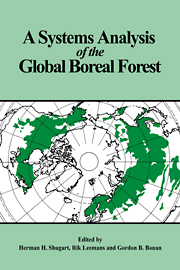Book contents
- Frontmatter
- Contents
- List of contributors
- 1 Introduction
- Part 1 Processes in boreal forests
- Introduction
- 2 Silvics of the circumpolar boreal forest tree species
- 3 The reproductive process in boreal forest trees
- 4 Soil temperature as an ecological factor in boreal forests
- 5 Fire as a controlling process in the North American boreal forest
- 6 The role of forest insects in structuring the boreal landscape
- Part 2 Patterns in space and time in boreal forests
- Part 3 Computer models for synthesis of pattern and process in the boreal forest
- References
- Index
5 - Fire as a controlling process in the North American boreal forest
Published online by Cambridge University Press: 12 January 2010
- Frontmatter
- Contents
- List of contributors
- 1 Introduction
- Part 1 Processes in boreal forests
- Introduction
- 2 Silvics of the circumpolar boreal forest tree species
- 3 The reproductive process in boreal forest trees
- 4 Soil temperature as an ecological factor in boreal forests
- 5 Fire as a controlling process in the North American boreal forest
- 6 The role of forest insects in structuring the boreal landscape
- Part 2 Patterns in space and time in boreal forests
- Part 3 Computer models for synthesis of pattern and process in the boreal forest
- References
- Index
Summary
Introduction
Major patterns of plant communities and species distribution are induced by various disturbance regimes operating at different spatial and temporal scales (Loucks 1970; White 1979; Bormann & Likens 1979b; Delcourt, Delcourt & Webb 1983). The development of temperate forests is controlled by canopy disturbance associated with single and multiple treefalls creating small gaps (Henry & Swan 1974; Oliver & Stephens 1977) and, occasionally, larger gaps along windstorm tracks (Canham & Loucks 1984). In contrast, fire disturbance in the boreal forest creates all sizes of canopy gap, and constitutes one of the most important community processes in vegetation development along complex environmental gradients (Heinselman 1981b). At the landscape level, ecological disturbances result in the spatiotemporal development of the vegetation mosaic composed of an assemblage of stand patches of different age, areal extent, and floristic composition (Pickett & White 1985).
The boreal forest is one of the world's two largest forest belts; it covers more than 126 km2 (Baumgartner 1979). The North American segment of the circumboreal forest, which constitutes a well-delineated biome both geographically and ecologically (Fig. 5.1), will be analyzed here with respect to fire disturbance. The boreal forest (excluding the Cordilleran region) spans more than 10° of latitude in eastern and western Canada; it is somewhat contracted south of Hudson Bay and James Bay, and in Alaska. At the continent scale, the boreal forest is a floristically poor biome (Takhtajan 1986) with only nine tree species dominating regionally or throughout the range, in coexistence with a subdued under-canopy flora in dense stands and an ubiquitous cryptogamic flora in open stands.
- Type
- Chapter
- Information
- A Systems Analysis of the Global Boreal Forest , pp. 144 - 169Publisher: Cambridge University PressPrint publication year: 1992
- 177
- Cited by

